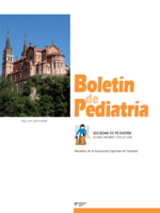Ginecomastia: fisiopatología y actualización de las opciones terapéuticas
F.J. Núñez Rodríguez , E. Artola Aizalde , V. Cancela Muñiz , C. Fernández Ramos , J. Rodrigo Palacios
Bol. Pediatr. 2010; 50 (214): 263 - 271
El término ginecomastia define un aumento del tejido glandular mamario en el varón que, generalmente, aparece en ciertos periodos de la vida como la época neonatal, puberal o senil, siendo la expresión de cierto disbalance en la acción de estrógenos y andrógenos en la glándula mamaria y que evoluciona, habitualmente, hacia la resolución espontánea. Generalmente es un proceso benigno en el que, habitualmente, no se encuentra el factor etiológico que la determina pero, de forma ocasional, puede ser la expresión de una alteración endocrinológica o tumoral subyacente. Aunque a día de hoy no hay tratamiento aceptado por la FDA y EMA para esta entidad, son múltiples los fármacos que se han utilizado en el tratamiento de la misma. En este trabajo se hace una revisión actualizada de las distintas opciones terapéuticas existentes, con una descripción esquemática de los factores etiopatogénicos y novedades aportadas en la literatura en relación con los mismos.
Ginecomastia: fisiopatology and update of the therapeutic options
The term ginecomastia defines an increase of the glandular mammary tissue in the male breast, that generally appears in some periods of the life as the period neonatal, puberal or senile, being the expression of certain disbalance in the action of oestrogens and androgens in the mammary gland and that usually progress towards the spontaneous resolution.
It is usually a benign process, in which habitually we don´t know the etiologic factor that determines it, but occasionally, it can be the expression of an endocrinologycal or tumour underlying alteration. Though nowadays there is no treatment accepted by the FDA and EMA for this entity, there are multiple medicaments that have been used in the treatment of the same one.
In this work, we do an updated review of the different therapeutic existing options, with a schematic description of the etiopathogenic factors with some reviews of innovations contributed in the literature in relation to the same ones.
Artículo completo (PDF) (148 kb.)
- Endocrino-Metabolismo
Buscar en el boletín
Año 2010, Volumen 50, Número 214

Boletín completo en PDF (1288 kb.)
En esta edición...
- Editorial (1 artículos)
- Revisiones (2 artículos)
- Originales (1 artículos)
- Casos clínicos (4 artículos)
- Acceso libre a la información científica (1 artículos)
- Curso de Nefrología Pediátrica (2 artículos)
- Trastornos del aprendizaje (1 artículos)
- En la jubilación del Dr. Emilio Álvaro Iglesias (1 artículos)
- Fe de erratas (1 artículos)
- Noticiario (1 artículos)
- Índices (1 artículos)